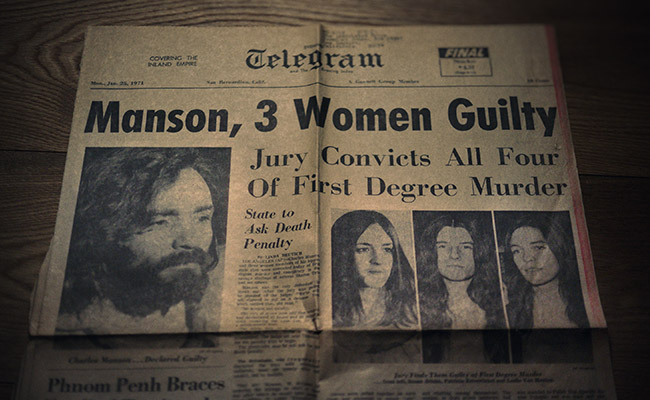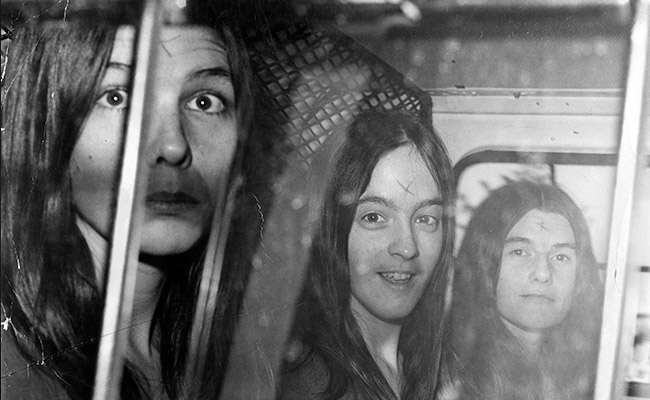
Epix
The sixth and final episode of the Epix docuseries Helter Skelter: An American Myth comes to a close this week and really takes us into the trail of Charles Manson and the Family members who were involved in the murders of Donald ‘Shorty’ Shea, Gary Hinman, Steven Parent, Abigail Folger, Voytek Frykowski. Jay Sebring, Sharon Tate (and her unborn child), and Leno and Rosemary LaBianca. The prosecution had their work cut out for them since Manson was not physically involved in the killings (although he did tie up the LaBianca’s, but as with the Tate murders, he told the actual killers to follow the orders of Tex Watson). It was their burden to prove it was Manson’s influence over the killers that guided them.
But the prosecution had their own problems internally. Vincent Bugliosi became famous as the lead prosecutor on the case, and he had no problem telling anyone who would listen that he was hand-picked out of hundreds of attorneys in Los Angeles to handle the case. According to Ivor Davis, that wasn’t exactly true. The original prosecutor’s bosses didn’t like his too cozy relationship with the press, so he was taken off the case and Bugliosi was added along with Stephen Kay, who was told if Bugliosi became a problem that he would take over. Kay managed to stay out of the spotlight but he wasn’t off of Manson’s radar, who promised Kay the same thing would happen at his house that happened at Tate’s and issued death threats from prison over the years.
Bugliosi became famous for using The Beatles’ ‘Helter Skelter’ as the centerpiece of the case, the song that Manson and his followers believed contained secret messages just for Manson that told of a coming race war. That certainly worked in Bugliosi’s favor but … it wasn’t his idea. He just was made aware of it and ran with it without giving credit where it was due: Ivor Davis, who had spent several days with the Family at the Spahn Ranch, fascinated by this group and their story, while being baffled by the whole notion that The Beatles would encode secret messages into a record specifically for Charles Manson. How would they even know who Manson was? Cult members aren’t really prone to asking those kinds of questions. Davis published a book, Five to Die, a few months before the trial began and he was a bit surprised to find the information in his book being used by Bugliosi at the trial. But it was what it was.
This episode includes a lot of footage from outside the trial, with Family members walking the hallsof justice singing songs, some of Charlie’s girls sitting outside the courtroom day and night (with one reporter being chastised for bringing them food because they never left their spot), and another group, which included Catherine Share. literally crawling on their hands and knees through the streets of Los Angeles to the courthouse. Share says she still has the scars from that although she managed to sand down the X mark she and the others carved into the foreheads at the space between their eyebrows.
The trial itself was a bit of a circus, nearly declared a mistrial at one point when Manson held up a newspaper with a headline stating President Nixon had declared them all guilty. The attorney was reprimanded for giving Manson the paper, and the trial was stopped so each member of the jury could be asked if the headline had any impact on their feelings about the case. As one juror stated, it was pretty foolish for the president to say something like that without any knowledge of the evidence that had been presented. Feeling confident in the jury, the judge refused to declare a mistrial and it carried on.
But it was former Family member Linda Kasabian who was Manson’s ultimate downfall. She was the lookout the night of the Tate murders, she saw the others did, she heard Patricia Krenwinkel complain of hurting her hand when her knife struck bone during the stabbing spree. It’s not mentioned in the episode, but Manson directed Kasabian to kill the actor Saladin Nader. She tried to tell Manson she could not kill someone but he didn’t listen so she went to the actor’s apartment and purposely knocked on the wrong door to make the others with her think Nader had moved. It worked and one potential victim was spared. Not long after that, Kasabian escaped from the ranch. She offered to testify with no conditions but the prosecution offered her immunity nonetheless.

Epix
Kasabian’s testimony did some damage but Manson still insisted he should go free because he never killed anyone. Tex Watson was the one who should be on trial (Watson had high-tailed it to Texas but was finally brought back to California ten months later). At one point, Catherine Share got a message from some of the girls with a written statement that she should deliver on the stand accusing Kasabian as the mastermind behind the killings. Manson wanted himself, Leslie Van Houten, Susan Atkins, and Patricia Krenwinkel to testify in their defense, but the three women ultimately decided not to, and Manson took the stand to ramble for more than an hour. During sentencing, Manson leapt for the judge and threatened to have someone cut off his head, but the judge remained calm and had the incident entered into the official record. The jury found all four guilty and then spent several days deciding the penalty. Bugliosi stated that he didn’t think they would have gotten a conviction without Kasabian’s testimony. All four were sentenced to death, but the death penalty was overturned in California in 1972 so all the sentences were reduced to life imprisonment. Watson was tried in a separate trial and was also sentenced to death, then reduced to life.
Of the three women, lawyers for Leslie Van Houten tried to have her separated from the group and tried separately since she was not involved in the Tate murders except for being the lookout, and she only stabbed Rosemary LaBianca after she was dead. But she was still seen as part of the larger group that did commit the crimes and the motion was denied. Her lawyer, Ronald Hughes, went missing during the trial in 1970. His body was found in 1971 but the cause of death was undetermined. Members of the Manson family claimed responsibility but no arrests were ever made.
In the end, Manson spent 47 years in prison, always denied parole to the point he quit going to the hearings. Susan Atkins had been the longest serving female prisoner until her death in 2009. That title is now held by Patricia Krenwinkel. Van Houten was granted a retrial in 1977 after the request for a mistrial after her lawyer died was declined. The second trial ended in a deadlocked jury and mistrial. She was tried again and convicted to seven years to life in prison in 1978. Since then, all parole requests for the women have been denied. Only one Family member has been released from prison on parole, Steven Grogan. Grogan had been found to be too stupid and too high on drugs to have made the decision to kill Donald Shea on his own and was under the influence of Manson. Grogan had initially received the death penalty but that new defense got his sentence reduced to life. Grogan later drew a map that led authorities to Shea’s body, and while in prison headed a program to help deter juveniles from a life of crime. He was released in 1985.
So, did we learn anything new from this docuseries, those of us who are old enough to have been around when it all happened 50 years ago? Some, but not much. The recounting of the trial probably contained the most new information as cameras were not allowed inside the courtroom at that time. With eyewitness accounts, including those of Juror #3, the circus atmosphere inside and outside of the court were brought vividly to life. And then we finally got to that one nagging question from the end of the first episode — if Manson wasn’t trying to start a race war to bring about the Apocalypse, then what was all this about? Reporter Sandi Gibbons says she doesn’t believe the whole ‘Helter Skelter’ theory but never elaborates on what she thinks Manson was really up to. Linda Deutsch also says she doesn’t believe that but then offers a ‘but if it wasn’t, then what was it?’ And … we never get an answer.
The Family members who did offer their recollections of their time with Manson — Dianne Lake, Catherine Share and Stephanie Schram — all agreed that a race war and the coming apocalypse was their main motivation for the Family moving to the desert. Manson has never said one way or the other, but everyone who was there was quite clear that Manson was obsessed with ‘Helter Skelter’, so those who were not present really have nothing to offer by doubting those claims and only served to dangle some carrot in front of the viewers that ultimately never paid off in the end.
Helter Skelter: An American Myth was no myth at all. It happened, the evidence provided by those involved was pretty conclusive, so casting doubts on that was fruitless. The series was interesting to watch, however, with its liberal use of archival footage and recreations so it id probably the best visual document of the Manson family. But 50 years later, and with Manson dead, it seems that perhaps everyone has finally said all they have to say on the matter and this can now be something for the history books.
What did you think of this episode? Sound off in the comments below!
